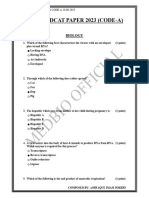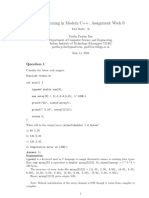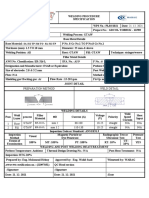0 ratings0% found this document useful (0 votes)
340 views4rth Semester Matlab Assignment Solved 70 Question
The document contains the code responses to various MATLAB questions. It includes code to:
1) Calculate the complex conjugate transpose of a matrix
2) Compare two matrices element-wise and find values greater than 1
3) Extract the diagonal and superdiagonal elements of a matrix
4) Remove zero elements from a vector
5) Plot a sine function with given inputs
6) Add text to a plot at a given position
7) Define and plot a custom function
8) Calculate statistics of a matrix
9) Sort a matrix in ascending and descending order
10) Find the zero of a custom function
Uploaded by
Uzair AshrafCopyright
© © All Rights Reserved
Available Formats
Download as DOCX, PDF, TXT or read online on Scribd
0 ratings0% found this document useful (0 votes)
340 views4rth Semester Matlab Assignment Solved 70 Question
The document contains the code responses to various MATLAB questions. It includes code to:
1) Calculate the complex conjugate transpose of a matrix
2) Compare two matrices element-wise and find values greater than 1
3) Extract the diagonal and superdiagonal elements of a matrix
4) Remove zero elements from a vector
5) Plot a sine function with given inputs
6) Add text to a plot at a given position
7) Define and plot a custom function
8) Calculate statistics of a matrix
9) Sort a matrix in ascending and descending order
10) Find the zero of a custom function
Uploaded by
Uzair AshrafCopyright
© © All Rights Reserved
Available Formats
Download as DOCX, PDF, TXT or read online on Scribd
You are on page 1/ 19
QUESTION: 1
Run the MATLAB code:
a = 1:5; d = a + i * a; e = d' f = d.'
Ans:
>> a=1:5;
>> d=a+i*a;
>> e=d'
e =
1.0000 - 1.0000i
2.0000 - 2.0000i
3.0000 - 3.0000i
4.0000 - 4.0000i
5.0000 - 5.0000i
>> f=d.'
f =
1.0000 + 1.0000i
2.0000 + 2.0000i
3.0000 + 3.0000i
4.0000 + 4.0000i
5.0000 + 5.0000i
QUESTION: 3
a = [1 2 3 4 ; 5 6 7 8 ; 9 10 11 12 ; 13 14 15 16]
a =
1 2 3 4
5 6 7 8
9 10 11 12
13 14 15 16
>> x = [ -5 -10 -15]
x =
-5 -10 -15
>>diagElement = diag (a)
diagElement =
1
6
11
16
>>diagMatrix = diag (diag (a))
diagMatrix =
1 0 0 0
0 6 0 0
0 0 11 0
0 0 0 16
QUESTION: 2
Given A =
1 2 4
1 1 1
2 3 1
and B =
2 2 2
2 2 2
2 2 2
Run the MATLAB code:
Greater = A > B
GreaterThanOne = A > 1
Ans:
>> a = [1 2 4 ; 1 1 1 ; 2 3 1]
a =
1 2 4
1 1 1
2 3 1
b = [2 2 2 ; 2 2 2 ; 2 2 2]
b =
2 2 2
2 2 2
2 2 2
greater = a > b
greater =
0 0 1
0 0 0
0 1 0
>>greaterThanOne = a > 1
greaterThanOne =
0 1 1
0 0 0
1 1 0
QUESTION: 4
Find a way to delete zeros from the vector x.
x = [0 6 0 7 3 0 3 0 2 2]
x =
0 6 0 7 3 0 3 0 2 2
>>x(x==0) = []
x =
6 7 3 3 2 2
QUESTION: 6
Ans:
>>name = upper('matlab')
name =
MATLAB
>>fun = strrep('hahahahahahahahahahahahahahahahaha','a','i')
fun =
hihihihihihihihihihihihihihihihihi
>> greet = 'Welcome'
greet =
Welcome
>>where = 'to Joan''s'
where =
to Joan's
>>party = 'birthday party'
party =
>>Dmatrix = diag (x)
Dmatrix =
-5 0 0
0 -10 0
0 0 -15
>>SuperdiagElement = diag (a,2)
SuperdiagElement =
3
>>NewMatrix = diag (diag(a,2))
NewMatrix =
3 0
0 8
>>SuperDiag = diag (diag(a,2),2)
SuperDiag =
0 0 3 0
0 0 0 8
0 0 0 0
0 0 0 0
birthday party
>>final = str2mat(greet, where, party)
final =
Welcome
to Joan's
birthday party
>>text = 'Monday, Tuesday, Wednesday, Thursday, Friday, Saturday, Sunday'
text =
Monday, Tuesday, Wednesday, Thursday, Friday, Saturday, Sunday
>> [day,rest] = strtok(text, ',')
day =
Monday
rest =
, Tuesday, Wednesday, Thursday, Friday, Saturday, Sunday
>> [day2,rest] = strtok(rest, ',')
day2 =
Tuesday
rest =
, Wednesday, Thursday, Friday, Saturday, Sunday
QUESTION: 5
Run the MATLAB code: x = [1/4 1 sqrt(2) .3]; y = sin(x); plot(y)
>> x = [1/4 sqrt(2) 3]
x =
0.2500 1.4142 3.0000
>> y = sin(x)
y =
0.2474 0.9878 0.1411
>> plot(y)
QUESTION: 7
The MATLAB code text(x,y,'alpha')
Places the letter alpha at position (x, y). Write the text \Graph of e-xsin 'at (.5, .2)
>> x=0:pi/40:2*pi;
>> y=sin(x);
>> plot(x,y)
>> text(0.5,0.2,'graph of e^{-x}sin\phi')
QUESTION: 8
Ans:
>> A=[1 1;2 2;3 3;4 100]
1 1
2 2
3 3
4 100
>> Average=mean(A)
Average =
2.5000 26.5000
>> Med=median(A)
Med =
2.5000 2.5000
>> Dev=std(A)
Dev =
1.2910 49.0068
QUESTION: 9
Ans:
>> A=[0 4 4;2 0 2;4 2 0];
>> [Asend,Ind]=sort(A)
Asend =
0 0 0
2 2 2
4 4 4
Ind =
1 2 3
2 3 2
3 1 1
>> Decend=flipud(sort(A))
Decend =
4 4 4
2 2 2
0 0 0
QUESTION: 10
Ans:
function [s] = sinm(x)
s=sin(x)-2.*x+2;
end
On command window
>> sinm_2(0:2*pi/40:2*pi);
>> fplot('sinm_2',[-10 10])
>> grid on
>> title('the function sin(x)-2.*x+2')
>> xzero=fzero('sinm_2',2)
xzero =
1.4987
QUESTION: 15
Ans:
>> %Dec2Bin will convert a number to binary equivalent
>> a=dec2bin(34)
a =
100010
QUESTION: 16
Ans:
function [] =etimef(~)
tic
num_length=1:100000;
toc
end
QUESTION: 17
Ans:
>> c=0:20:100;
>> %formula for changing degree Celsius into oF.
>> F= (9/5)*c+32;
>> e=c'
e =
0
20
40
60
80
100
>> g=F'
g =
32
68
104
140
176
212
>> convert_c_to_F=[e g]
convert_c_to_F =
0 32
20 68
40 104
60 140
80 176
100 212
(OR)
QUESTION: 17
Ans:
function [F,X] =temp(C)
C=([0:20:100])';
X=9./5.*C+32;
F=([X])';
fprintf(' C F\n');
fprintf(' (degree) (fahrenheight)\n');
fori=1:length(C);
fprintf('%8g %16g\n', C(i),F(i));
end
end
QUESTION: 18
. In Europe daylight time starts on the last Sunday of March and ends on the last Sunday of
October. Write a function that determines whether a given day number is in the summertime
period or in the wintertime period of the Daylight Saving Time
Ans:
function [f]= q18(datetime)
datetime= input('enter the date')
[yr,mon,dom,hr]=datevec(datetime);
dow=weekday(datetime)-1;
f = 'day numer is in summer time';
if (mon>4 &mon<10), return; end;
if (mon==4 &dom>7), return; end;
if (mon==4 &dom<=7 &dow==0 &hr>=2), return; end;
if (mon==4 &dom<=7 &dow>0 &dom>dow), return; end;
if (mon==10 &dom<25), return; end;
if (mon==10 &dom>=25 &dow==0 &hr<2), return; end;
if (mon==10 &dom>=25 &dow>0 & dom-24-dow < 1), return; end;
f ='day number is in winter time';
end
QUESTION: 21
Let be given the string `Need-to-split-this-string'. We want to break it into the -tive strings
`Need', `to', `split', `this', and `string'. Solutions may be based on strtok and the much faster
strread
Ans:
function [parts] =q21( ~ )
str='18c'
splitstr='[c]';
parts=regexp(str,splitstr,'split');
end
QUESTION: 22
We have a string that looks like `18C'. How to keep only the number 18?
Ans:
function [Result,N] =q22(~)
S='18c'
N = sscanf(S, '%d')
end
QUESTION: 23
We want to save a vector v=[1 2 3 4]; into a text file. How to that?
Ans:
V=[1 2 3 4]
>> save textfile.m V_ascii
%to save the file
>>load textfile.m
>>textfile
textfile=
1 2 3 4
QUESTION: 24
Write a code that removes all 2's in a matrix A
Ans:
function [ new] = q24(matrix )
matrix=input('enter matrix')
new=matrix(matrix==2);
end
OR
>> A=[2 2 6;3 2 6;2 7 4];
>> A(A==2)=[]
A =
3 7 6 6 4
QUESTION: 25
How can I comment several lines at once in stead of typing the symbol % at the beginning of
each line?
Ans:
>>if(0)
I am a student.
My name is Azeem.
I want peace.
end
%The text between if(0) and end will become comments
QUESTION: 26
How can I find where the matrix A changes sign?
>> A=[1 -6 -4;-7 8 3];
>> S=sign(A)
S =
1 -1 -1
-1 1 1
QUESTION: 28
Given an array like [2; 8; 3; 30; 4; 50; 100; 200; 4; 80; 500]. I want to split it into three arrays
with different ranges: [0-10), [10-100), and [100-1000).The above array should become
2; 8; 3; 4; 4
30; 50; 80
100; 200; 500
How to do this?
Ans:
function [split,b ] = q28(~)
% Result should look like 1 2 3 4...
% 8 9
% 16 17 18
a = [1 2 3 4 8 9 16 17 18];
b=a-(1:length(a));
b = [true; diff(b(:)) ~= 0; true];
split = mat2cell(a(:).', 1, diff(find(b)));
[m , n , o]=split{:}
end
QUESTION: 30
Is there a convenient way of listing the names of all *.m functions thatare called by a given
*.m function?
function [] =q30(n )
n=input('enetr the name of fuction whose subfuctions names you want to know=')
help 'n'
end
QUESTION: 31
How can one set the background of a figure view as white?
Ans:
function [] =q31(~)
set(gca,'color','white')
whitebg('white')
end
(OR)
>>figure=figure(color,[1 1 1])
QUESTION: 32
How can one simulate a curve shaped like a heart by a spline function?
Ans:
function [] = q32(~)
n=100;
x=linspace(-3,3,n);
y=linspace(-3,3,n);
z=linspace(-3,3,n);
[X,Y,Z]=ndgrid(x,y,z);
F=((-(X.^2) .* (Z.^3) -(9/80).*(Y.^2).*(Z.^3)) + ((X.^2) + (9/4).* (Y.^2) + (Z.^2)-1).^3);
isosurface(F,0)
lightingphong
caxis
axis equal
colormap('flag');
view([55 34])
end
QUESTION: 37
I want to index the entries in a matrix by using vectors with row and column indices. How to
do that?
Ans:
function [ out_args ] =q37( in_args)
q=magic(4)
q = [16 2 3 13
5 11 10 8
9 7 6 12
4 14 15 1]
idx = sub2ind(size(q), [2 3 4], [1 2 4])
idx = [ 2 7 16]
end
QUESTION: 38
function [ output_args ] =q38( input_args )
k=10
disp(fprintf('this is the number=%d',k))
end
QUESTION: 39
. I want to display variable values inside a disp command: \This is number: k". How to do
that?
Ans:
>> line([1,1],[2,0],'marker','*','color','r','linestyle',':')
>> clf
>> line([1,1],[2,0],'marker','*','color','r','linestyle',':')
>> line([3,1],[2,4],'marker','+','color','g','linestyle','--')
>> line([2,2],[3,4],'marker','>','color','b','linestyle','-')
>> axis([-5 5 -5 5])
QUESTION: 41
function [ output_args ] =q41( input_args )
x1=-3:.2:3;
x2=-3:.2:3;
[X,Y] = meshgrid(x1,x2);
f = (X-3).^2 + (Y-3).^2;
g = 10.*(X + Y);
ix = g >= 4;
f(ix)=200;
surf(X,Y,f)
grid on
end
QUESTION: 42
How do I create a maximized figure window?
function [ output_args ] =q42( input_args )
gcf = q41
set(gcf,'Units','normalized','Position',[0.00 0.034 1.00 0.905])
end
(OR)
>>h=figure;
>>pause (0.1)
>>Jf=get(h,javaframe);
>>set(Jf, maximized ,1);
QUESTION: 43
I have to plot a variable number of data sets on the same graph with different symbols. How
can I specify the symbols I want to use? How can I specify the order and color of the symbols
to be used?
function [ output_args ] = q43( input_args )
xlabel({'x red';'x1 green'})
ylabel({'y red';'y1 green'})
end
QUESTION: 44
function [ output_args ] = q44( input_args )
p=[-100:100];
q=1:sum(p>=1)
p(q)
end
QUESTION: 45
function [ ] = q45(~)
x=-1:.1:1;
y=x;
[xx,yy]=meshgrid(x,y);
zz=(16-xx.^2).^(1/2);
mesh(xx,yy,zz)
title('The graph of z=(16-x^2)^(1/2)')
xlabel('x-axis')
ylabel('y-axis')
zlabel('z-axis')
axis tight
end
QUESTION: 46
I have a char array '000101'. Is there any way to split this into six separate elements: '0' '0'
'0' '1' '0' '1'?
function [parts] =q46( ~ )
str='0 0 0 1 0 1'
splitstr=[' '];
parts=regexp(str,splitstr,'split');
end
QUESTION: 47
How can I store strings of variable length? [Hint use cell arrays]
function [ output_args ] = q47( input_args )
userinput={'AJ48 NOT'; 'AH43 MANA'; 'AS33 NEWEF'};
disp(userinput{1});
end
QUESTION: 48
function [ output_args ] =q48( input_args )
fid = fopen('use.m', 'r')
x = fread(fid,inf)
end
QUESTION: 50
>> x=1:4;
>> y=1:10;
>> c=find(ismember(x,y))
c =
1 2 3 4
>> %where 1 2 3 4 are inices of matching entries
(OR)
function [ output_args ] =q50( input_args )
a =[2 3 1 2]
b=[2 1 7 2]
ind=find(a==b)
end
QUESTION: 51
function [ output_args ] =q51( input_args )
a=[1 2 -3 ; 0 9 0 ; 0 8 -1];
a(find(a<0))=[0]
end
QUESTION: 52
function [ output_args ] = q52( input_args )
A=[1 2 ; 3 4 ; 5 6; 6 7; 8 9 ; 5 4; 7 8; 8 0 ; 3 2; 1 1; 2 2; 3 3; 4 4; 5 6; 7 8]
newmatrix=[A(1,:);A(5,:) ; A(10,:);A(15,:)]
end
QUESTION: 53
function [ output_args ] =q58( input_args )
files = dir('*.txt');
fori=1:length(2)
eval(['load ' files(i).name ' -ascii']);
end
end
QUESTION: 54
function [ output_args ] = q59( input_args )
A=[1 2 3 4 5; 6 7 8 9 10]
A=reshape(A,1,10)
selectfirsteight=A(1:8)
end
QUESTION: 55
function [ output_args ] = q55( input_args )
F=[1 2 3; 4 5 6; 7 8 9]
A=[3 -2 1];
B=[6 9 -4];
C=[-7 -5 2];
a=cat(3,A,B,C)
A = [0 -a(3) a(2); a(3) 0 a(1); -a(2) a(1) 0]
crossproduct=cross(A,F)
end
QUESTION: 56
function [ output_args ] = q56( input_args )
a = [1 2 3]'
b = [2 4 7]'
div=a./b
why=[1 2 3]/[2 4 7]
end
QUESTION: 58
function [ output_args ] =q58( input_args )
load penny;
figure;
contour(flipud(P))
colormap('Copper')
end
QUESTION: 58 (a)
function [ output_args ] =q58a( input_args )
Z = peaks;
[C,h] = contourf(Z,10);
text_handle = clabel(C,h);
colormap([1 1 0])
set(text_handle,'BackgroundColor',[1 1 0],...
'Edgecolor',[1 1 0])
caxis([-20 20])
title({'Filled Contour Plot Using','contourf(Z,10)'})
end
QUESTION: 59
function [ output_args ] = q59( input_args )
end
QUESTION: 60
function [ output_args ] = q60( input_args )
set(0,'defaulttextinterpreter','latex')
end
QUESTION: 61
function [ output_args ] = q61( input_args )
x=[1 2 3 4 ]
plot(x,cos(x),'-ro',x,sin(x),'-.b')
list={'Label 1','Label 2'};
leg=legend(list);
set(leg,'Textcolor',[1 1 0])
end
QUESTION: 62
function [ output_args ] = q62( input_args )
set(gca,'color','none')
whitebg('blue')
whitebg([0 .5 .6])
end
QUESTION: 63
function [ output_args ] = q63( input_args )
set(0,'defaulttextinterpreter','latex')
x=[1 2 3 4];
y=[ 2 5 6 7]
x1=[6 3 7 8]
x2=[ 0 9 7 6]
plot(x,y,'-og',x1,x2,'--r>')
end
QUESTION: 64
function [ output_args ] = q64( input_args )
tcell = {[1,0], [1,2,3], [3,2,1,4]};
lens = cellfun('length', tcell);
rmat = NaN(length(tcell), max(lens));
fori = 1:length(tcell)
rmat(i, 1:lens(i)) = tcell{i}
end
QUESTION: 65
function [ output_args ] =q65( input_args )
c={'Bob', 'Mary', 'Fred','Ken'}
s = fprintf(' %s %s \n' , c{1} ,c{3} );
end
QUESTION: 66
function [ output_args ] = q66( input_args )
%calllib('libname', 'funcname', arg1, ..., argN)
loadlibrary('MatlabGenericDll','GenericDll.h')
calllib('MatlabGenericDll', 'FormatDrive')
unloadlibraryMatlabGenericDll
end
QUESTION: 67
Solve the equation ax2+ bx + c = 0 symbolically for x, and next for b.
unction [ output_args ] = q67( input_args )
syms x a b c
solve('a * x ^ 2 + b * x + c=0','x')
solve('a * x ^ 2 + b * x + c=0','b')
end
QUESTION: 68
. Solve the equation [cos (2x) + sin(x) - 1 = 0 ]symbolically. Next use ezplot to verify the result
function [ output_args ] = q68( input_args )
syms x
solve('cos(2*x) + sin(x) - 1 = 0','x')
ezplot('cos(2*x)', -2, 3)
hold on
ezplot('1-sin(x)', -2, 3)
xlabel('cos(2*x)')
hold off
end
QUESTION: 69
Solve the equation tan(x) + sin(x) - 2 = 0 symbolically. Next, determine the numerical values
of the roots.
>>syms x
>>f=tan(x)=sin(x)-2
>>solve(f);
>>sol=sub(f,x,1.5)
Sol=
2.168
(OR)
function [ output_args ] = q69( input_args )
%You can find this solution by calling the MuPAD numeric solver directly and specifying
the interval where this solution can be found. To call MuPAD commands from the MATLAB
Command Window, use the evalin or feval function
solve('tan(x)+sin(x)-2=0','x')
evalin(symengine, 'numeric::solve(tan(x)+sin(x)-2, x = 0..4)')
end
You might also like
- Laboratory Studies in Integrated Principles of Zoology 18th EditionNo ratings yetLaboratory Studies in Integrated Principles of Zoology 18th Edition54 pages
- Sindh Mdcat Paper 2023 Code-A With Official Key70% (10)Sindh Mdcat Paper 2023 Code-A With Official Key44 pages
- Coding Club Level 3 Python Building Big Apps PDF100% (1)Coding Club Level 3 Python Building Big Apps PDF134 pages
- Instruction: Perform The Numbered Procedures and Do The Tasks and Answer The Questions AfterNo ratings yetInstruction: Perform The Numbered Procedures and Do The Tasks and Answer The Questions After10 pages
- Solución de La Asignación 1 Del Curso de R: 1. SolucionesNo ratings yetSolución de La Asignación 1 Del Curso de R: 1. Soluciones14 pages
- Assignment #1 Control Systems Lab: Submitted By: Submitted ToNo ratings yetAssignment #1 Control Systems Lab: Submitted By: Submitted To6 pages
- Week 1: Name: Lokesh Kumar REG NO: 20BCE1683 Subject: Mat1011 - MatlabNo ratings yetWeek 1: Name: Lokesh Kumar REG NO: 20BCE1683 Subject: Mat1011 - Matlab11 pages
- Matlab Report File: Amity School of Engineering and TechnologyNo ratings yetMatlab Report File: Amity School of Engineering and Technology8 pages
- Simulation and Modelling Lab: Veer Surendra Sai University of TechnologyNo ratings yetSimulation and Modelling Lab: Veer Surendra Sai University of Technology16 pages
- R For Machine Learning Lab Practical Work: Master of Business Administration in Business Analytics0% (1)R For Machine Learning Lab Practical Work: Master of Business Administration in Business Analytics9 pages
- MATLAB Project Subject: Linear Algebra: 3. SolutionsNo ratings yetMATLAB Project Subject: Linear Algebra: 3. Solutions20 pages
- Content of Homework Should Start From This Page OnlyNo ratings yetContent of Homework Should Start From This Page Only9 pages
- Merged Assignment Programming in Mordern C++ All AnswersNo ratings yetMerged Assignment Programming in Mordern C++ All Answers195 pages
- SOLUTION - PRACTICE - Introduction To MATLAB100% (1)SOLUTION - PRACTICE - Introduction To MATLAB2 pages
- R - (2017) Understanding and Applying Basic Statistical Methods Using R (Wilcox - R - R) (Sols.)No ratings yetR - (2017) Understanding and Applying Basic Statistical Methods Using R (Wilcox - R - R) (Sols.)91 pages
- Analytic Geometry: Graphic Solutions Using Matlab LanguageFrom EverandAnalytic Geometry: Graphic Solutions Using Matlab LanguageNo ratings yet
- A Brief Introduction to MATLAB: Taken From the Book "MATLAB for Beginners: A Gentle Approach"From EverandA Brief Introduction to MATLAB: Taken From the Book "MATLAB for Beginners: A Gentle Approach"2.5/5 (2)
- Pages From Beecher Penna Bittinger Algebra Trigonometry 4th TXTBK100% (1)Pages From Beecher Penna Bittinger Algebra Trigonometry 4th TXTBK2 pages
- Uzair Ashraf M12-PG-18 Hassaan Nazir M12-CE-50No ratings yetUzair Ashraf M12-PG-18 Hassaan Nazir M12-CE-508 pages
- Citizenship: Pakistani Date of Birth: 15 Oct 1994: Ali ArshadNo ratings yetCitizenship: Pakistani Date of Birth: 15 Oct 1994: Ali Arshad1 page
- Post Applied For: Process Operator Muhammad ASHRAF: ObjectiveNo ratings yetPost Applied For: Process Operator Muhammad ASHRAF: Objective3 pages
- Citizenship: Pakistani Date of Birth: 15 Oct 1994: Ali ArshadNo ratings yetCitizenship: Pakistani Date of Birth: 15 Oct 1994: Ali Arshad1 page
- Assignment No.: 6: Institute of Chemical Engineering and Technology, PUNo ratings yetAssignment No.: 6: Institute of Chemical Engineering and Technology, PU1 page
- Attachment 2 GRD Request and Inquiry FormRIF 2No ratings yetAttachment 2 GRD Request and Inquiry FormRIF 22 pages
- Siemens Simatic S7-1200 - PLC-City - PLC-CityNo ratings yetSiemens Simatic S7-1200 - PLC-City - PLC-City12 pages
- Pessing Libya INC: SA 312 TP 316 TO SA 312 TPNo ratings yetPessing Libya INC: SA 312 TP 316 TO SA 312 TP1 page
- CSEC - Nutrition Powerpoint Scribd VERSION100% (1)CSEC - Nutrition Powerpoint Scribd VERSION20 pages
- Welcome: Puskesmas Iv Denpasar Selatan (Public Health Centre)No ratings yetWelcome: Puskesmas Iv Denpasar Selatan (Public Health Centre)33 pages
- A New Radar Waveform Design Algorithm With Improved Feasibility For Spectral CoexistenceNo ratings yetA New Radar Waveform Design Algorithm With Improved Feasibility For Spectral Coexistence10 pages
- Forouzan MCQ in Introduction To Data Communications and NetworkingNo ratings yetForouzan MCQ in Introduction To Data Communications and Networking13 pages
- Promotional Strategies & Print Ad For Cold Creams100% (1)Promotional Strategies & Print Ad For Cold Creams12 pages
- Standards For 7-Day and 28-Day Strength Test ResultNo ratings yetStandards For 7-Day and 28-Day Strength Test Result1 page
- 3ms All Sequences Lesson Plans Worksheets Tutorial SessionsNo ratings yet3ms All Sequences Lesson Plans Worksheets Tutorial Sessions110 pages
- 99.poultry Breeding and Multiplication Center OkNo ratings yet99.poultry Breeding and Multiplication Center Ok21 pages
- Laboratory Studies in Integrated Principles of Zoology 18th EditionLaboratory Studies in Integrated Principles of Zoology 18th Edition
- Instruction: Perform The Numbered Procedures and Do The Tasks and Answer The Questions AfterInstruction: Perform The Numbered Procedures and Do The Tasks and Answer The Questions After
- Solución de La Asignación 1 Del Curso de R: 1. SolucionesSolución de La Asignación 1 Del Curso de R: 1. Soluciones
- Assignment #1 Control Systems Lab: Submitted By: Submitted ToAssignment #1 Control Systems Lab: Submitted By: Submitted To
- Week 1: Name: Lokesh Kumar REG NO: 20BCE1683 Subject: Mat1011 - MatlabWeek 1: Name: Lokesh Kumar REG NO: 20BCE1683 Subject: Mat1011 - Matlab
- Matlab Report File: Amity School of Engineering and TechnologyMatlab Report File: Amity School of Engineering and Technology
- Simulation and Modelling Lab: Veer Surendra Sai University of TechnologySimulation and Modelling Lab: Veer Surendra Sai University of Technology
- R For Machine Learning Lab Practical Work: Master of Business Administration in Business AnalyticsR For Machine Learning Lab Practical Work: Master of Business Administration in Business Analytics
- MATLAB Project Subject: Linear Algebra: 3. SolutionsMATLAB Project Subject: Linear Algebra: 3. Solutions
- Content of Homework Should Start From This Page OnlyContent of Homework Should Start From This Page Only
- Merged Assignment Programming in Mordern C++ All AnswersMerged Assignment Programming in Mordern C++ All Answers
- R - (2017) Understanding and Applying Basic Statistical Methods Using R (Wilcox - R - R) (Sols.)R - (2017) Understanding and Applying Basic Statistical Methods Using R (Wilcox - R - R) (Sols.)
- Analytic Geometry: Graphic Solutions Using Matlab LanguageFrom EverandAnalytic Geometry: Graphic Solutions Using Matlab Language
- A Brief Introduction to MATLAB: Taken From the Book "MATLAB for Beginners: A Gentle Approach"From EverandA Brief Introduction to MATLAB: Taken From the Book "MATLAB for Beginners: A Gentle Approach"
- Pages From Beecher Penna Bittinger Algebra Trigonometry 4th TXTBKPages From Beecher Penna Bittinger Algebra Trigonometry 4th TXTBK
- Citizenship: Pakistani Date of Birth: 15 Oct 1994: Ali ArshadCitizenship: Pakistani Date of Birth: 15 Oct 1994: Ali Arshad
- Post Applied For: Process Operator Muhammad ASHRAF: ObjectivePost Applied For: Process Operator Muhammad ASHRAF: Objective
- Citizenship: Pakistani Date of Birth: 15 Oct 1994: Ali ArshadCitizenship: Pakistani Date of Birth: 15 Oct 1994: Ali Arshad
- Assignment No.: 6: Institute of Chemical Engineering and Technology, PUAssignment No.: 6: Institute of Chemical Engineering and Technology, PU
- Welcome: Puskesmas Iv Denpasar Selatan (Public Health Centre)Welcome: Puskesmas Iv Denpasar Selatan (Public Health Centre)
- A New Radar Waveform Design Algorithm With Improved Feasibility For Spectral CoexistenceA New Radar Waveform Design Algorithm With Improved Feasibility For Spectral Coexistence
- Forouzan MCQ in Introduction To Data Communications and NetworkingForouzan MCQ in Introduction To Data Communications and Networking
- Standards For 7-Day and 28-Day Strength Test ResultStandards For 7-Day and 28-Day Strength Test Result
- 3ms All Sequences Lesson Plans Worksheets Tutorial Sessions3ms All Sequences Lesson Plans Worksheets Tutorial Sessions






































































































